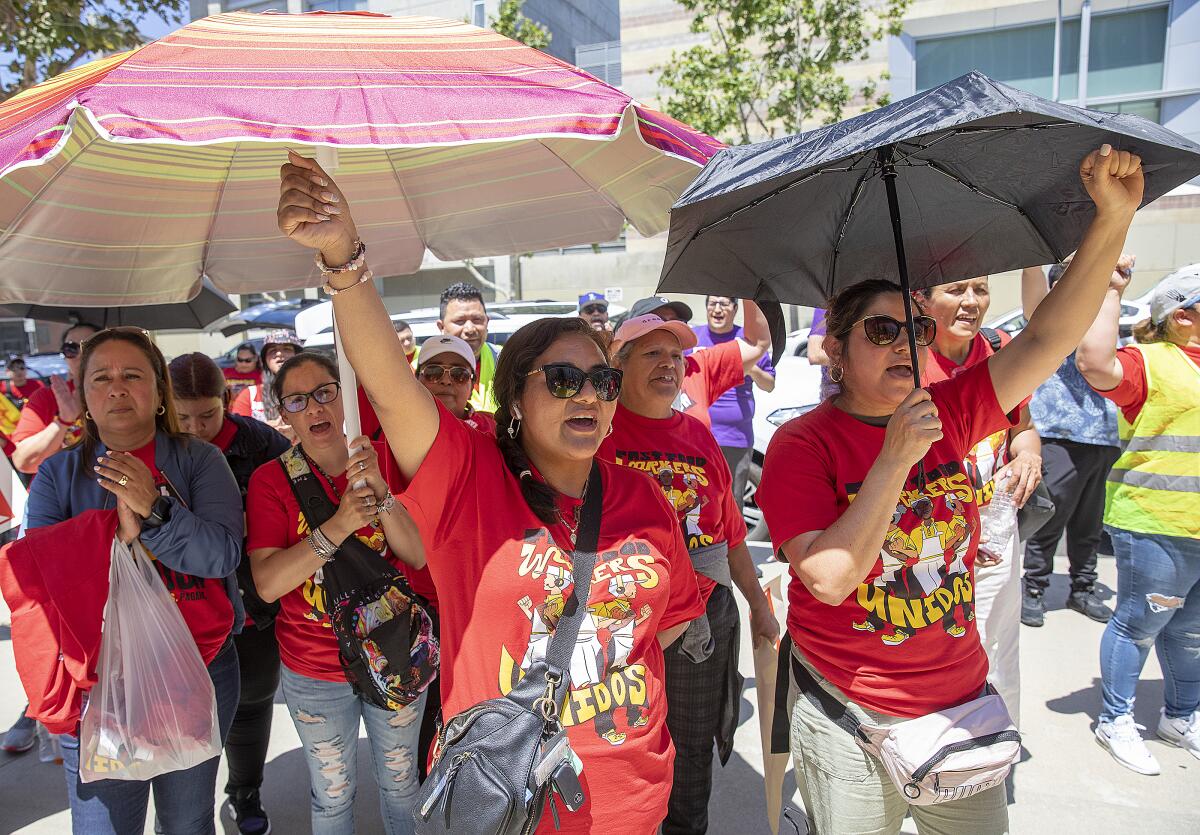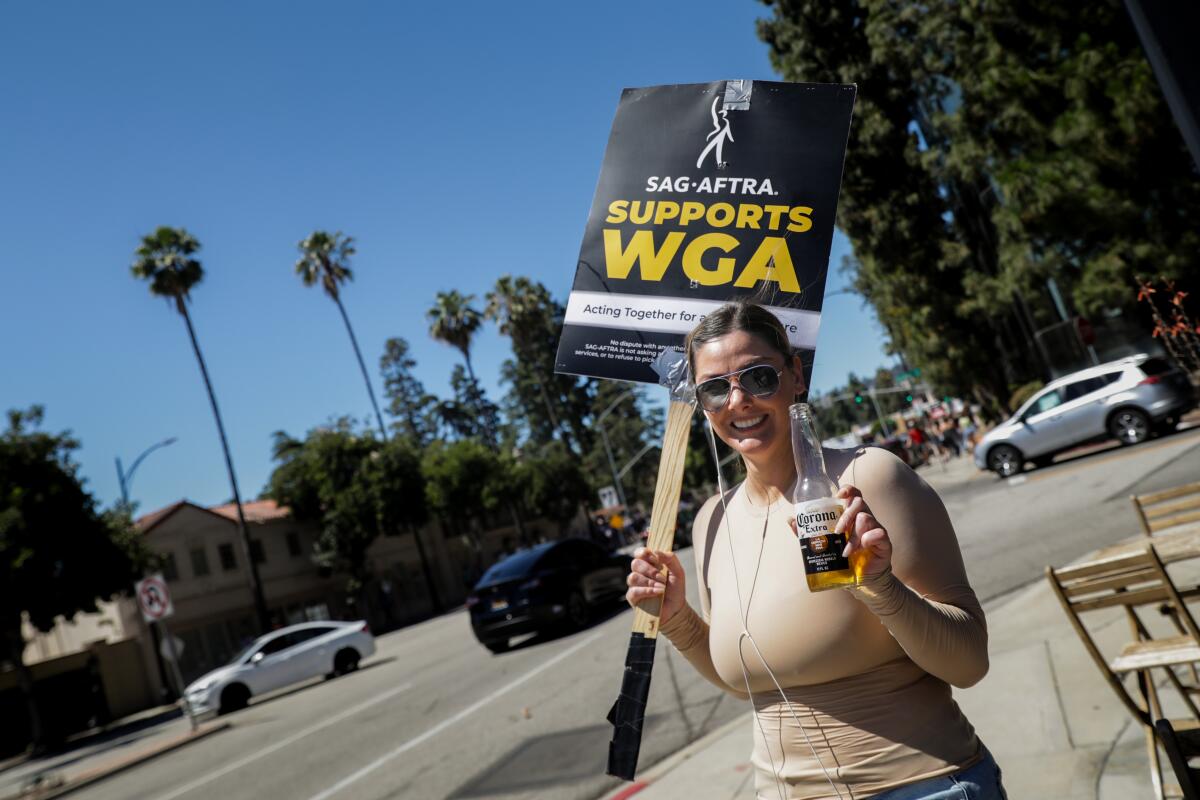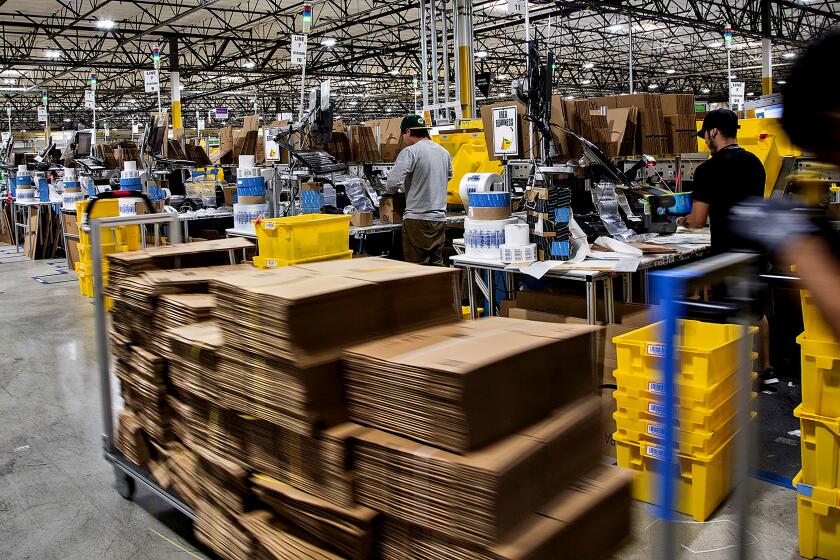Dangerous heat wave during ‘hot labor summer’ — how picketing workers brave the sun

- Share via
It is shaping up to be a “hot labor summer” — literally.
As the region plunges into a record heat wave, Southern California workers across multiple industries are hitting steamy sidewalks and scorching asphalt to picket in front of iconic Los Angeles hotels, fast-food restaurants and major Hollywood studios — to name a few. It’s sweat-inducing and so potentially dangerous that the Writers Guild of America canceled New York picketing during one of that region’s hottest days last week.
For fast-food workers, the broiling conditions are nothing new. Protesting outside during a heat wave is even a welcome break for some. Those in hot restaurant kitchen facilities without adequate air conditioning are among workers least protected by California’s heat safety standards — with state regulators sluggish to create new regulations that keep pace with accelerating climate change.
“You’re joking right?” said Maria Liehr, 58, a Del Taco supervisor, when asked if the heat wave was a concern.
Church’s Texas Chicken employee Rosaura Ramos had a similar reaction as she joined Liehr and about 100 other fast-food workers at a Thursday morning rally outside the Los Angeles Chamber of Commerce in downtown Los Angeles.
“We work in a very hot area,” said Ramos, 47. “We need to make more money.”
The push by organized labor to have California lawmakers enact first-in-the-nation standards for fast-food workers has stretched into a years-long battle.
At 11 a.m. Thursday it was already 86 degrees. By 3 p.m., when fast-food workers staged a second protest outside a McDonald’s in East L.A., the temperature had climbed to 92 degrees.
Workers in front of the McDonald’s took shelter under black umbrellas stamped with “Fast food justice ahora!” Others sat using their hands to block the sun or scurried to the shade under the overhang of the McDonald’s during lulls. A man began distributing water bottles to workers from the back of his truck.
On Friday, as actors, writers and others took to the streets with picket signs, it was even hotter. Labor leaders have dubbed this a season of labor solidarity under the rallying cry, “hot labor summer.”
Striking Hollywood actors and screenwriters set up tents, layered in sweat-wicking clothing and donned sun visors. The heat did not seem to put a damper on turnout — bolstered by an influx of newly striking workers.
WGA members have been on strike since May 2, and on Friday they were joined by members of actors union SAG-AFTRA on the initial day of that strike, marking a historic converging of labor actions by the two unions — the first in 63 years.

Outside Fox Studios in Century City, a breeze blowing a cooling mist from a nearby fountain made the weather more bearable. Still, the unions are advising people to stay within their limits, said Jefferey Reeves, a SAG-AFTRA member.
Reeves patrolled a crosswalk wearing a hat and sunglasses and said he has been mixing liquids and various electrolyte powders to create hydrating “concoctions.”
“The heat has changed the game quite a bit,” Reeves said. “I don’t do well in the heat, as a rule. So I’ve been turned on by the writers to certain products that hydrate.”
Although extreme weather is hard on those walking outdoor picket lines, the real concern for many workers is high temperatures on the job.
Rajpal Singh, 40, has been baking in the high desert sun on a small picket line outside an Amazon facility in Palmdale. He’s among about 80 unionized delivery drivers — represented by the International Brotherhood of Teamsters — that Amazon terminated in late June.
During this month’s historic heat wave, employees at Amazon’s largest West Coast air freight facility were conducting their own workplace temperature checks.
Singh and other workers organized last year to demand better heat safety conditions when temperatures topped 100 degrees. In the backs of the cargo vans where delivery drivers rummage through packages on their delivery routes, temperatures might be 10 to 15 degrees higher.
The Teamsters union reached an agreement last month with delivery giant UPS to install air conditioning systems in its brown delivery trucks. The tentative deal comes as the two parties continue to negotiate the terms of a new contract for more than 340,000 unionized employees and after reports of UPS workers facing extreme heat in their vehicles while on the job.
Despite the union’s win on that front, UPS delivery drivers are poised to join the ballooning ranks of striking Southern California workers if the union and the company don’t reach a deal by July 31, the nationwide contract expiration date. The Teamsters union has been holding “practice” picket lines around the city in preparation.
From 1992 to 2017, about 815 U.S. workers died of heat stress, according to the Bureau of Labor Statistics. More than 70,000 were injured.
California was the first state to establish heat exposure standards for outdoor workers, after multiple farmworkers died from heat-related causes in 2005. The rules require employers to provide access to fresh water and shade, as well as training about heat illness prevention and planning.
But the California Division of Occupational Safety and Health, or Cal/OSHA, has lagged on creating regulations for indoor workers despite a legal deadline to have an indoor heat standard in place by 2019. Temperatures at massive Inland Empire warehouses, many of which lack air conditioning, can climb above 90 degrees, making workers sick.
The agency held a public hearing in May on proposed worker heat protections, but final action isn’t expected for months — certainly not in time for other heat waves expected this season.
As Angelenos sweat through extreme temperatures, workers are doing whatever they can to cool off, from drinking two gallons of water to wearing ice packs and a fan.
TV writer and producer Rachel Lewis on Friday helped direct Writers Guild of America strikers from the shade of a tent outside Amazon Studios in Culver City. As a strike captain, she’s been stationed there for months.
Lewis said she just bought shorts to wear even though she hates having her legs exposed, but she’s resolved to do whatever it takes to make sure “everybody is being safe” during the heat wave and keep the picket line going.
“Nothing will deter me from coming out to strike,“ Lewis said. “We have extra sunscreen, we have extra water, we have extra ice. We have misters, and we’re just making sure as captains that people stay hydrated and take breaks and get shade.”
The morning weather is more forgiving, but with picket lines going until 2 p.m., people on the later shifts start to suffer, said Peter Meech, a member of both SAG-AFTRA and WGA West.
“I wouldn’t be surprised to see the hours curtailed,” Meech said. “It may be curtailed in terms of the distance people march and the times that people actually protest.”
On Friday, Meech brought along Poppy the pug, his “strike animal,” to the picket line at Fox Studios. Worried about the small black dog’s safety, Meech sequestered himself on the sidelines, periodically waving his sign at passersby from his and Poppy’s spot in the shade. A staff member brought Poppy a cup of water.
“The heat is extraordinary, and if you have a strike animal ... you have to be doubly careful about it,” Meech said. “There are water stations along the picket route here, but it does make you think twice about how long you’ve been on strike.”
More to Read
Inside the business of entertainment
The Wide Shot brings you news, analysis and insights on everything from streaming wars to production — and what it all means for the future.
You may occasionally receive promotional content from the Los Angeles Times.
















